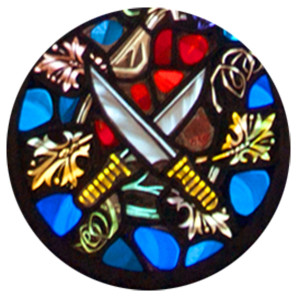6 o’clock. Knives. Bartholomew (also likely named as Nathaniel). The tradition is that Bartholomew was flayed and then crucified. In Michelangelo’s painting of the Last Judgment in the Sistine Chapel, Bartholomew is the apostle holding his own skin. Ouch.
Hold on Kerry. Are these guys that you are blogging on, the same guys that left Jesus during his arrest in Gethsemane and ran like frightened school boys? (Mark 14: 50)
Yes, they are.
So now they are heroes of the faith standing up for Christ to the point of martyrdom? This is a rather amazing transition.
Yes it is.
So what caused their rapid spiritual growth spurts?
Some pretty substantial events took place after the crucifixion. These include, but are not limited to: The Resurrection, the post-Resurrection Appearances of Christ, and Pentecost. For me, seeing a risen Christ, and yes, perhaps sticking my finger into his side, together with the indwelling and work of the Holy Spirit would dramatically accelerate my faith. Simply reading and reflecting on these events grows my faith.
Would I run off at the first sign of trouble? Jesus asks this question in a much deeper way in Mark 10:38: 38 Jesus said to them, “You do not know what you are asking. Are you able to drink the cup that I drink, or to be baptized with the baptism with which I am baptized?” I will discuss this text and answer the question above throughout the remainder of this blog.
Besides the depiction in Michelangelo’s Last Judgment, The Martyrdom of Saint Bartholomew is also rendered in a more palatable form by the Spanish artist Jusepe de Ribera. The fully clothed figure in the center sharpens a knife in the dark area below his right shoulder. Again, this is from the Baroque period.
In part 11, we move to Matthew at the 7 o’clock position.

